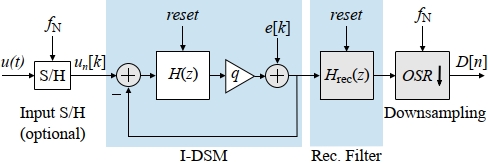High-Resolution, Efficient Incremental Sigma-Delta Modulators
Sigma-Delta (ΣΔ) ADCs are suitable for various applications, due to its oversampling and noise-shaping behavior, thus high resolutions can be achieved independent on the matching accuracy of the analog components. For multiplexed applications, where an ADC is used to digitize the input coming from multi-channels, a sample-by-sample conversion is necessary. Regardless of the many advantages of Sigma-Delta ADCs, each output sample is dependent on the preceding one, therefore, a sample-by-sample conversion is not possible. As a result, Nyquist-rate ADCs (e.g SAR ADC) are dominant in the field of multiplexed applications.
On the other hand, Incremental Sigma-Delta (I-ΣΔ) ADCs have gained an increased interest in the past few years, as they inherit the basic properties of a freely-running ΣΔ modulators, however by resetting the internal states of the modulator and the following digital filter within the ADC (Fig. 1), a sample-by-sample conversion is obtained, and a true Nyquist-rate conversion is achieved. This allows I-ΣΔ ADCs to compete with other Nyquist-rate ADCs (e.g. SAR ADC) with the potential of achieving high resolutions, due its insensitivity to element mismatches.
The field of I-ΣΔ modulators is considered a trending young field of research, with many unexplained phenomena and unique properties different from the freely-running ΣΔ ADC, giving it an extra degree of freedom. Thus, more solutions and ideas to overcome the design challenges and achieve high-resolution power efficient designs are much desired.

Publications
- Kässer, P.; Ismail, O.; Wiens, D.-P.; Ortmanns, M.
Offset Cancellation in Incremental ∆Σ ADCs
IEEE International Symposium on Circuits and Systems (ISCAS), Singapore, Mai 2024
DOI: 10.1109/ISCAS58744.2024.10557952 - Kässer, P.; Wagner, J.; Ismail, O.; Ortmanns, M.
Inner Transfer Functions in Incremental ΔΣ ADCs
IEEE Transactions on Circuits and Systems II: Express Briefs, April 2024
DOI: 10.1109/TCSII.2024.3390397 - Ismail, O.; Kässer, P.; Kauffman, J. G.; Ortmanns, M.
Non-Ideal Reset in Incremental Delta-Sigma ADCs
IEEE 22nd Interregional NEWCAS Conference Sherbrooke, Quebec, Canada, April 2024 - Ismail, O.; Kässer, P.; Kauffman, J. G.; Ortmanns, M.
DAC Element Mismatch Shaping Algorithms in Incremental Delta-Sigma ADCs
IEEE International Symposium on Circuits and Systems (ISCAS), Singapore, Januar 2024
DOI: 10.1109/ISCAS58744.2024.10558337 - Kässer, P.; Ismail, O.; Wagner, J.; Fischer, R.; Ortmanns, M.
Frequency-Domain Analysis of Reconfigured Incremental ΔΣ ADCs on the Example of the Exponential Phase
IEEE Transactions on Circuits and Systems I: Regular Papers, September 2023
DOI: 10.1109/TCSI.2023.3310655 - Mokhtar, M. A.; Ismail, O.; Vogelmann, P.; Kauffman, J. G.; Ortmanns, M.
A 40 kS/sCalibration-Free Incremental △Σ ADC Achieving 104 dB DR and 105.7 dB SFDR
ESSCIRC 2023- IEEE 49th European Solid State Circuits Conference (ESSCIRC), Lisbon, Portugal, pp. 401-404, September 2023
DOI: 10.1109/ESSCIRC59616.2023.10268735 - Kässer, P.; Ismail, O.; Rudorf, C.; Wagner, J.; Ortmanns, M.
Linear-Exponential I-DS ADCs: Analysis, Limitations and Higher Order
IEEE International Symposium on Circuits and Systems (ISCAS), Monterey, CA, USA, pp. 1-5, Mai 2023
DOI: 10.1109/ISCAS46773.2023.10182215
